ROCCAT Vulcan 120 AIMO

Today, we look at a mechanical gaming keyboard from the German manufacturer ROCCAT, and it is a little different from all the other cubs in the pride.
Usually, keyboards with mechanical switches are known to be rather clunky, due to the size of the switches themselves. But ROCCAT have decided to stir things up with their Vulcan series, and they have now given us the first low-profile mechanical keyboard.
We have received the top model of the series, called Vulcan 120 AIMO. Low profile doesn’t mean turning down the flash, and the RGB spectacle is full blown here. But does everything beneath live up to the RGB display of confidence, and, more importantly, how do Rocco’s brand-new self-invented Titan switches, perform?
Unboxing – A first look
Let’s get right to the unpacking. The box features the usual picture of the product, and the back highlights the build quality, Titan switches, and loads of RGB. The keyboard itself is sealed in an antistatic wrap.
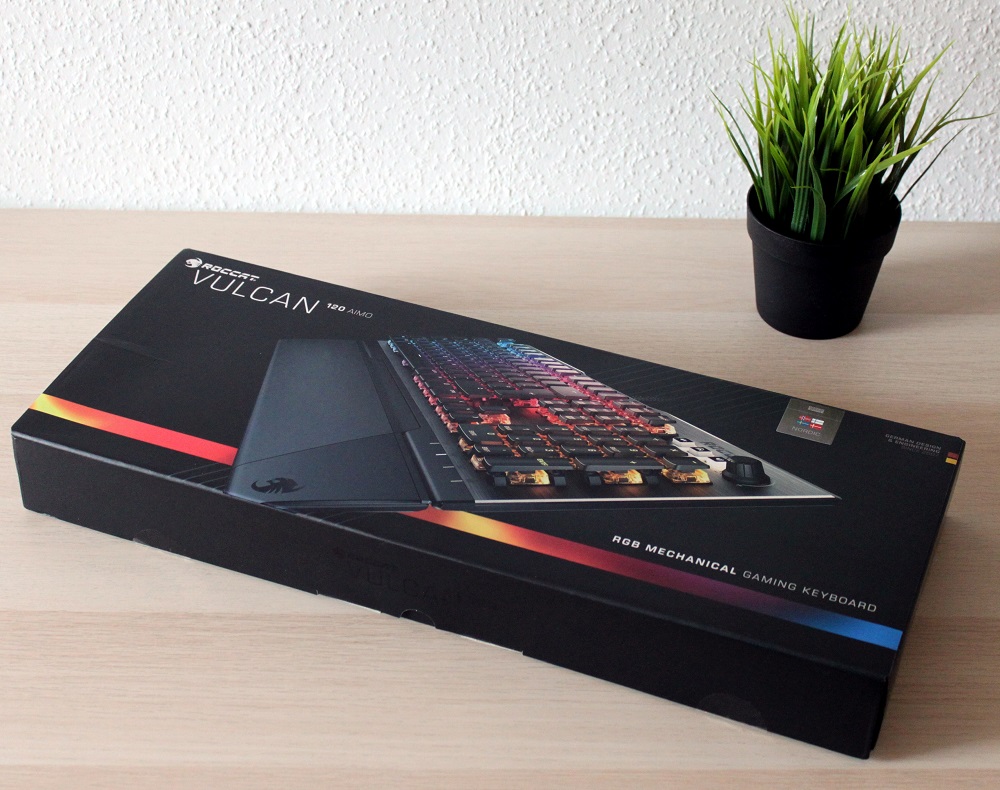
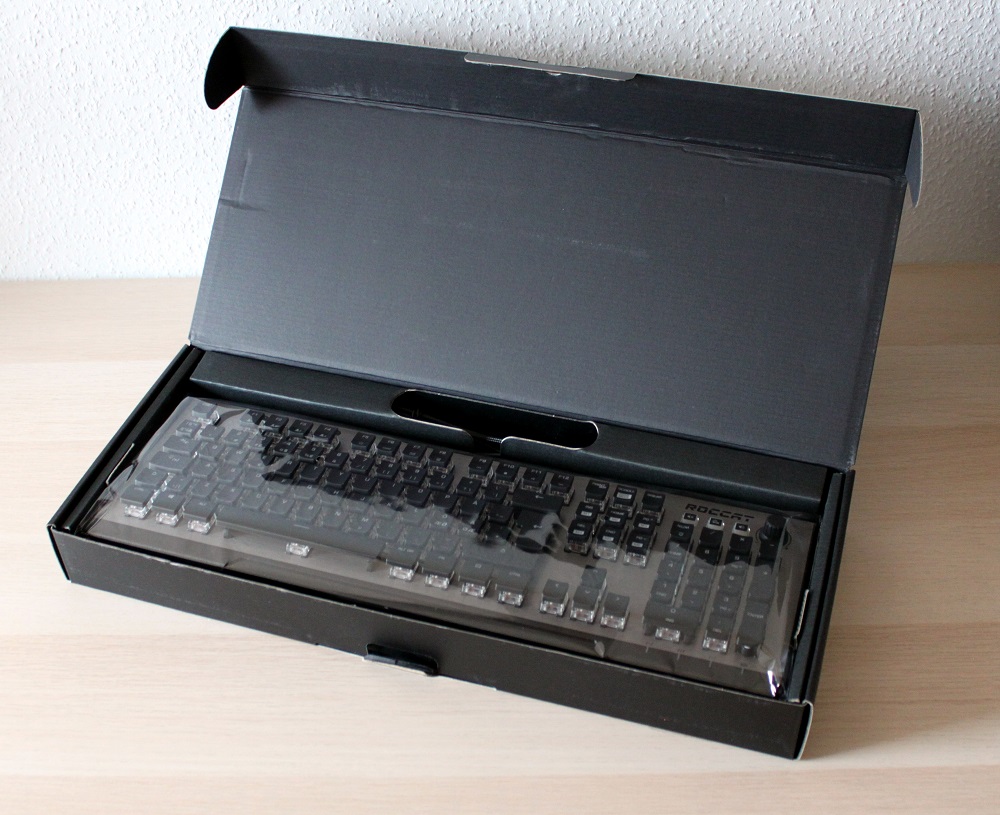
Besides the keyboard, the box contains some ROCCAT stickers and an ergonomic palm rest which is thin, minimalistic, and has anti-slip rubber mounted underneath. This keeps the keyboard in place on most surfaces.
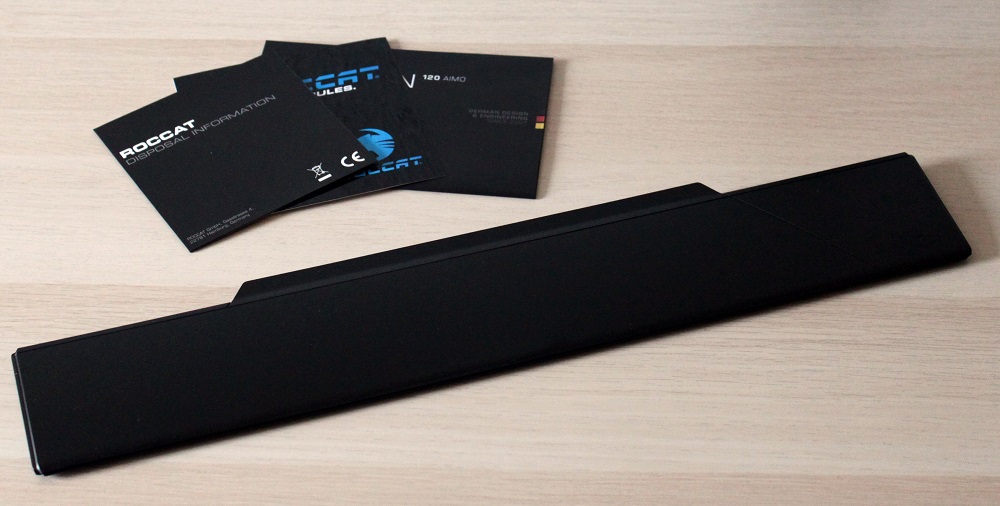
But let’s focus on the keyboard for a moment. It is minimalistic and stylish in with black keys on a brushed metal surface, like many modern keyboards. If we zoom in, however, we see an eye for detail, e.g., the tiny ROCCAT Vulcan brand on the USB connector.
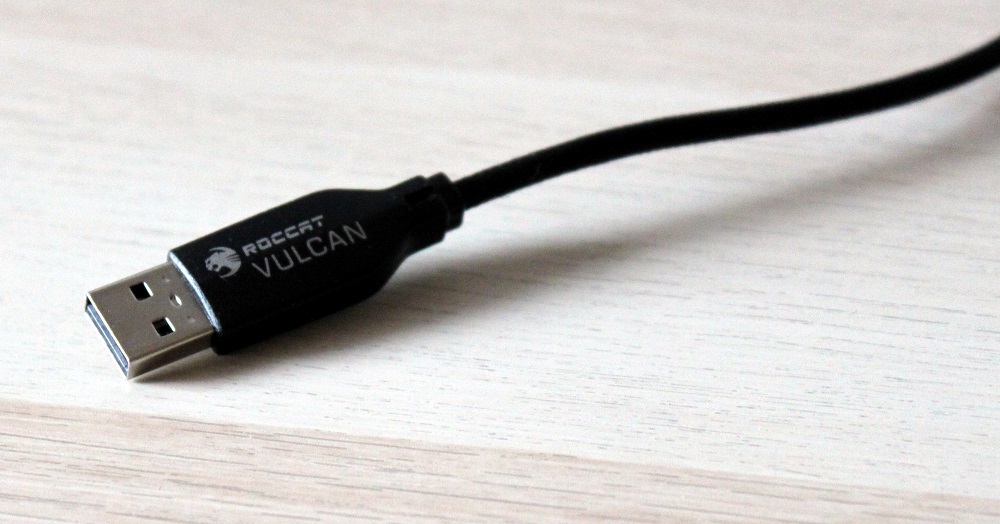
In the upper right corner, above the numpad, we find some interesting features. Here, we find a mute button, an FX button, and a speaker button. These are paired with a multi-function knob which adjusts volume and can be customized for a second function through the included software. More about that later.
Like any other modern keyboard, the F-keys contain some expanded functions. F1-F4 allow you to change between four profiles that you can save in the keyboard’s internal memory. F5-F8 are shortcuts, and F9-F12 are used to control media.
All functions are accessed with the FN-key which is placed on the right side of the space bar.
The indicator lights for num, caps, and scroll lock are placed below the numpad, and not above it. A fourth indicator light signals if the keyboard is in “Game Mode”, a special setting that, among other things, turns off the Windows key.
But it is actually the side view that really makes the keyboard stand out. From here, it is evident that this model is slimmer than anything. The mechanical switches hover above the brushed aluminum plate, like any other modern keyboard. However, the switches are not as tall as the standard, and the same goes for the buttons that sit on top. They are paper thin!
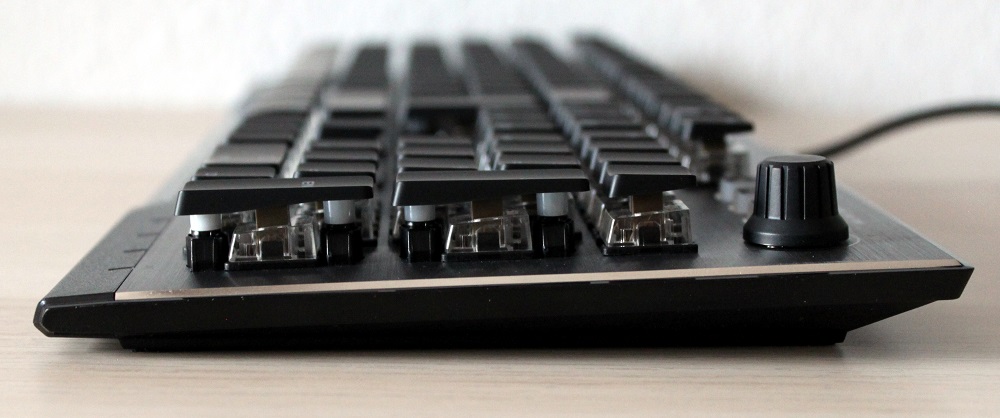
Of course, the buttons can be removed. Just pull them. The Titan switches beneath are golden brown and look nothing like any regular switches I have seen. ROCCAT don’t reveal who they have collaborated with in engineering these, but Cherry, Gateron, of Kailh would be good bets, as they are the key players in this area (pun intended).
A tiny, almost unseen, detail is the ROCCAT logo printed on every single switch. Too small to catch with our camera. But a nice touch.
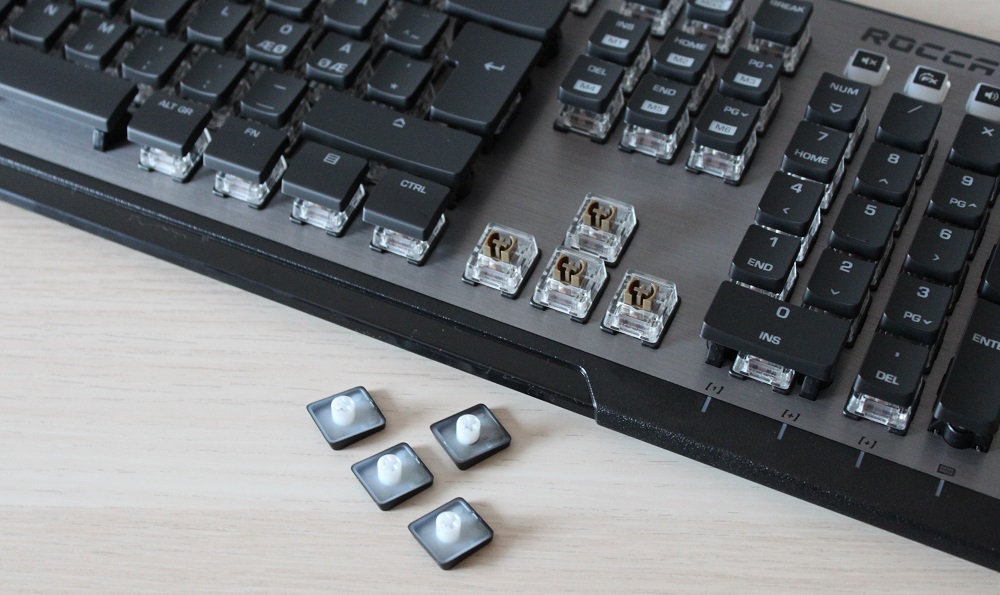
Let’s remount those keys and turn the board around. Here, we find four extended rubber feet providing a stable position on every surface. Two feet in the corners provide a further angle when out. These are also provided with rubber soles.
Below, you can see the keyboard with its feet up and down. When down, they give a substantial angle, which I personally prefer. Notice the svelteness and grace of the keyboard, even with its feed down. I’m impressed.
Feet up:
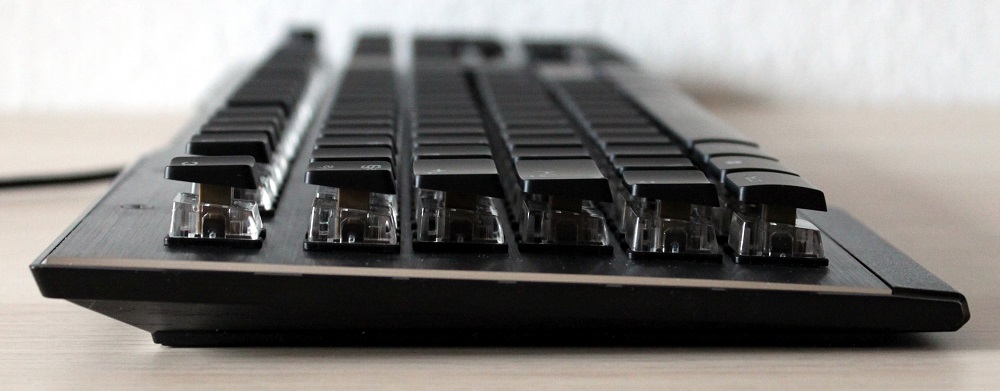
Feet down:
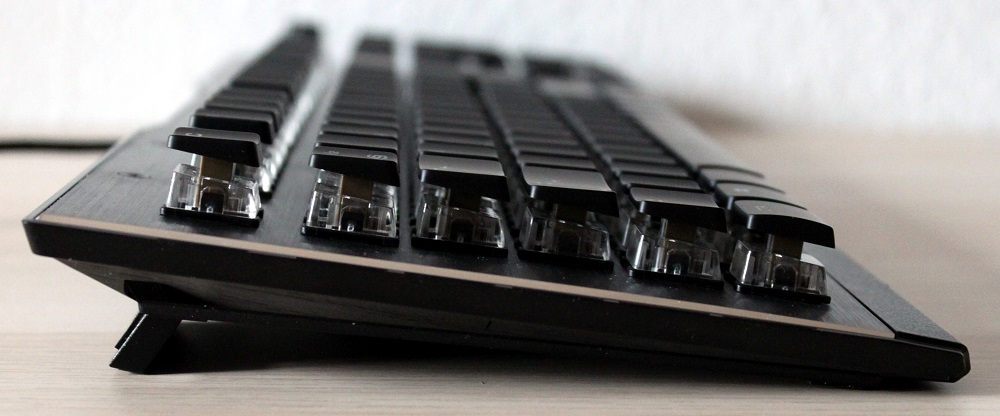
Before moving on to the software, let’s look at the palm rest. Like the Vulcan keyboard, it is thinner than an M. Night Shyamalan plot, and I was afraid that it was as loose as well. Luckily, ROCCAT have provided it with magnetic connectors that cling it on to the keyboard like a bloodthirsty leach, even when you are pulling it and dragging it around the table.
The software – ROCCAT Swarm
We plug in the keyboard and open the software. The ubiquitous update delays us a few minutes, but that makes time for a coffee…
After the caffeine fix, the software provides three tabs: Basic settings, key assignment, and key illumination.
(We'll give you a screenshot here, but we only have one in the arcane and alluring Danish language, so it's for illustrative purposes only. Unless you have a rosetta stone.)
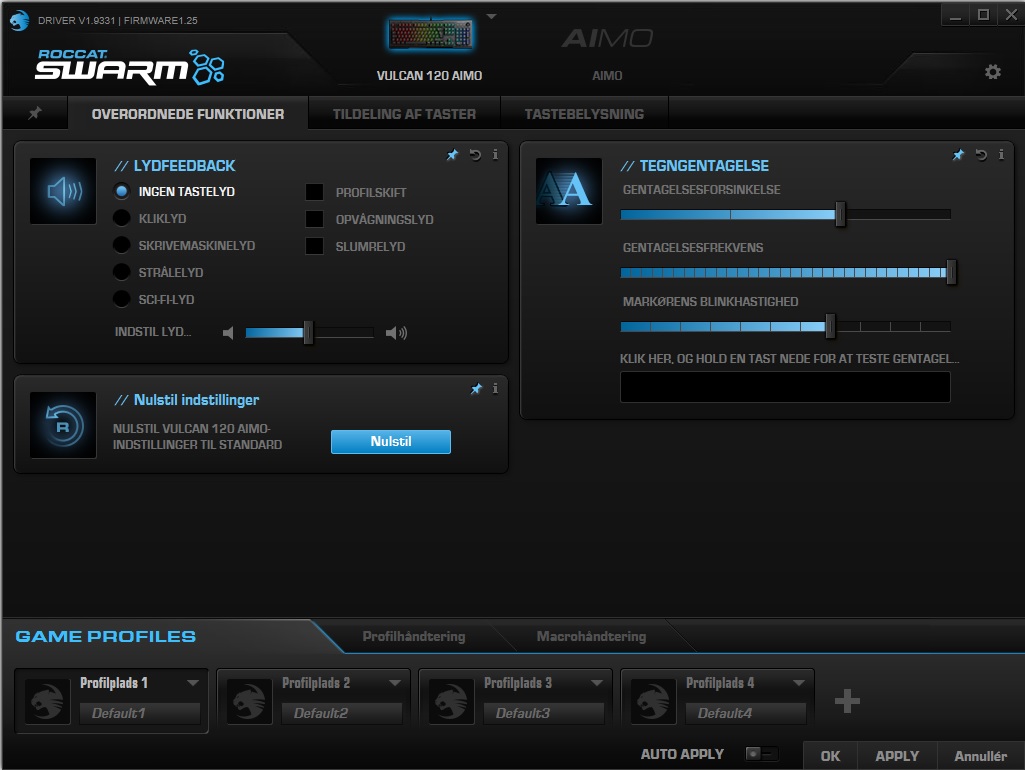
Basic settings allow us to adjust the delay on repeated entries, blink speed on the marker in, e.g., Word, etc. Fairly straightforward. If you for some reason can’t live without clicks in your headphones every time you press down a button, you have that option too.
The second tab enables us to change the functions of different keys, for instance, the FX key that lets you personalize the corner knob. You have a selection of predefined profiles to choose from, if you don’t find the energy or inspiration to build your own.
The final tab customizes everything RGB on the keyboard. Here, you also have a selection of predefined settings for your taking, you can change color, or which buttons to illuminate If you take your personalization seriously, you can even tailor every single button to your own preference. These settings, however, are not as intuitive as we have seen elsewhere.
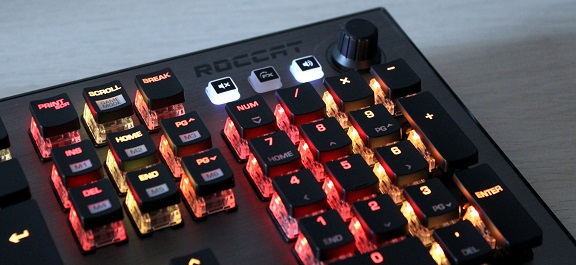
The game profiles section at the bottom of the screen gives us access to four profiles that can be reached at any time with the F1-F4 function keys.
Down here, we also find the profile manager that opens in a new window. Here, we can import and export different profiles to the keyboard. You can rename them and mix them however you want. This is especially useful if you have created more than the four readily available profiles.
The same goes with the macro manager, also accessible on the bottom panel. Here, you can record your own profiles instead of creating them the old-fashioned way. The process is straightforward and works almost like a charm, but there are a small number of issues. Most notable is the lack of stability – the software froze a few times, and I had to restart. This unfortunately meant starting over, as changes were not saved on the fly.
From the main menu, you can also access the AIMO panel. In short, AIMO is an intelligent RGB-light created by ROCCAT. By activating it, AIMO learns your patterns and lights the keyboard accordingly. The more AIMO-peripherals you connect and the longer you use them, the better it becomes at giving you a badass lighting experience. At least according to ROCCAT. Whether it is a gimmick or not, I cannot say. I’m not that big an RGB-connoisseur.
With that out of the way, let’s pound away and test the damn thing!
The test – Comfort, use, and RGB
We’ve come to the main course. Trying out the keyboard, not just writing about it on another keyboard.
As always, we examine certain aspects. First, we check the comfort. Then we explore the different uses. Here, I’m referring to switches, layout, extra functions, shortcuts, etc. And finally, RGB, which is mostly a visual review presented in the pictures below. Lighting is subjective, so you be the judge.
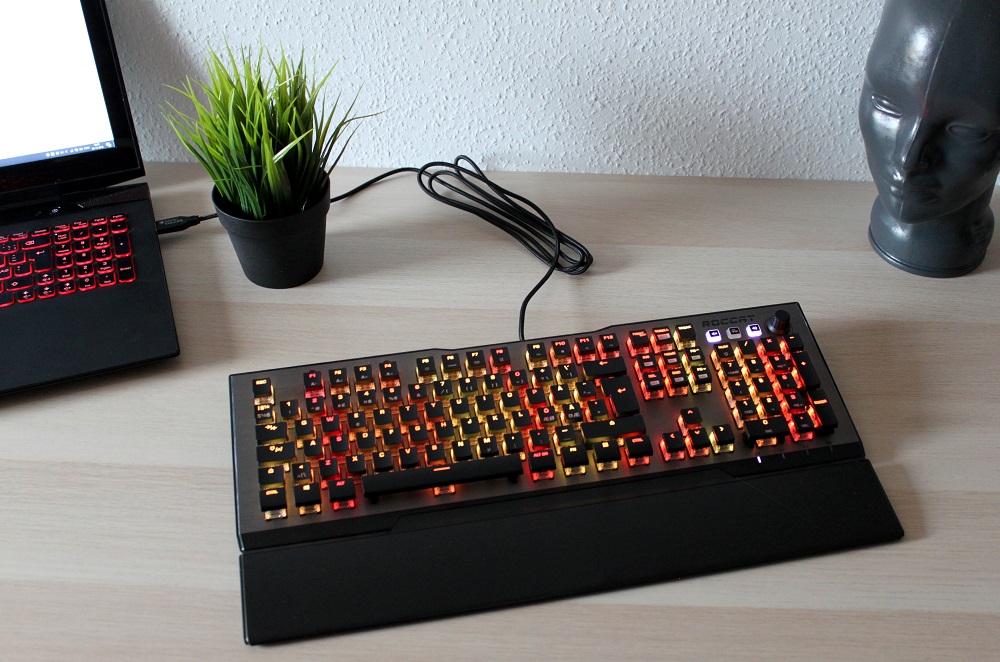
Comfort
Already from a first glance, the almost tenuous stature of both keyboard and palm rest made me tremble in pure anticipation. Vulcan is without a doubt the slimmest mechanical keyboard I have seen to date.
This fine trim plays a significant, and positive, part in the comfort of the ROCCAT keyboard.
I’m a sucker for palm rests. Naturally, mounting it to the keyboard was the first thing I did. I also decided to go feet down do give me an angle, something I’m used to with my normal SoundBlasterX Vanguard K08. Which, BTW, is a lot thicker.
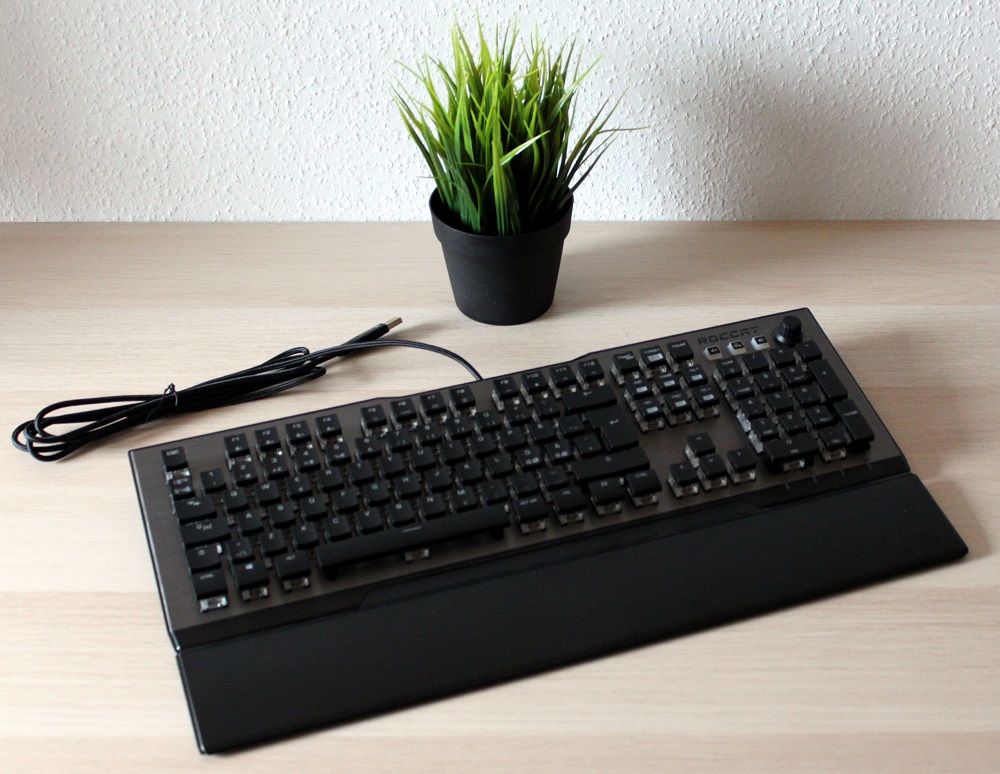
Due to the slenderness of Vulcan 120 AIMO, the transition from table to keyboard is unnoticeable. This means that you can rest your palms without bending them. I was able to keep comfortable for hours.
As mentioned earlier, the connectors are magnetic, and surprisingly strong. They make the rest cling to the keyboard, even if you drag it around the table. That’s true magnetic power!
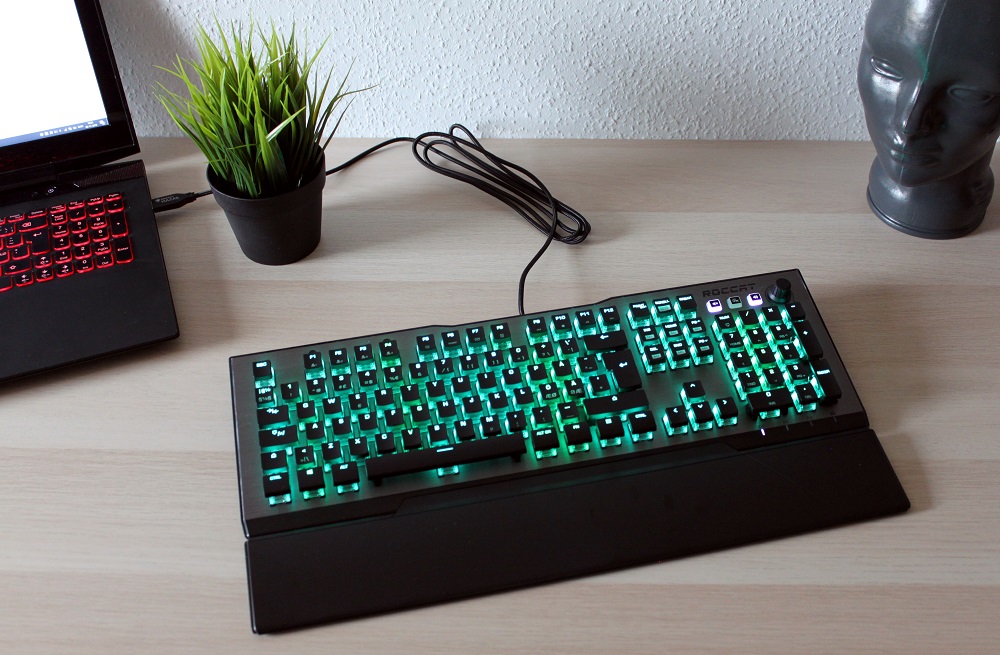
In other words, I couldn’t be any happier with comfort. It was spot on.
One flaw, though, is that the edges of the keys are rather sharp. Even though this is a microscopic criticism, my fingers would've appreciated some rounder edges.
Use
Besides being skinnier than a 90’s supermodel, Vulcan is the first series to introduce the new ROCCAT Titan switches.
They don’t look or feel like anything else out there. They are much slimmer than normal Cherry switches, for instance. With an actuation point of only 1.8mm and a total switch travel distance of 3.6mm, nothing seems out of the ordinary, besides the slimness. To compare, a regular Cherry MX switch is usually activated at 1.5mm, and their MX Speed switches only need 1.2mm. But that’s on paper.
But the Titan switches feel incredibly fast. My normal Vanguard K08 keyboard uses the signature SoundBlasterX PRES switches. These feature an actuation point of 1.5mm and a switch travel distance of 3.5mm. This is less than the Titan switches, so in theory faster.
However, this doesn’t feel to be the case. I don’t know if it’s my imagination and enthusiasm getting the better of me, but after a couple of days’ use I had significantly increased my speed. This happened both while typing and while gaming.
Both the actuation point and the switch travel distance are higher on Vulcan, so I suspect that the slimness of the buttons plays a part in this. Moving your fingers across the keys feels much easier. You don’t have to lift them as much, and you are consequently able to press the key faster. At least, that is my theory…
I would absolutely recommend that you try out the Titan switches. They truly are something special. If you are a hardcore keyboard aficionado, and you have yet to try them, I can add that they feel like a mixture of Cherry MX Red and Brown. In my estimation, the noise level is also about the same.
All in all, the new Vulcan keyboard from ROCCAT is a delight, and in many ways truly unique compared to other mechanical keyboards.
The many functions available through the FN key are a nice feature. I would have liked some dedicated one-touch buttons for media control, however. Like play/pause, forward/rewind, etc. It’s a minor detail, FN + F9-F12 do the job, but still…
RGB
As you can see on all the pictures around, the RGB light is incredibly luscious and bright.
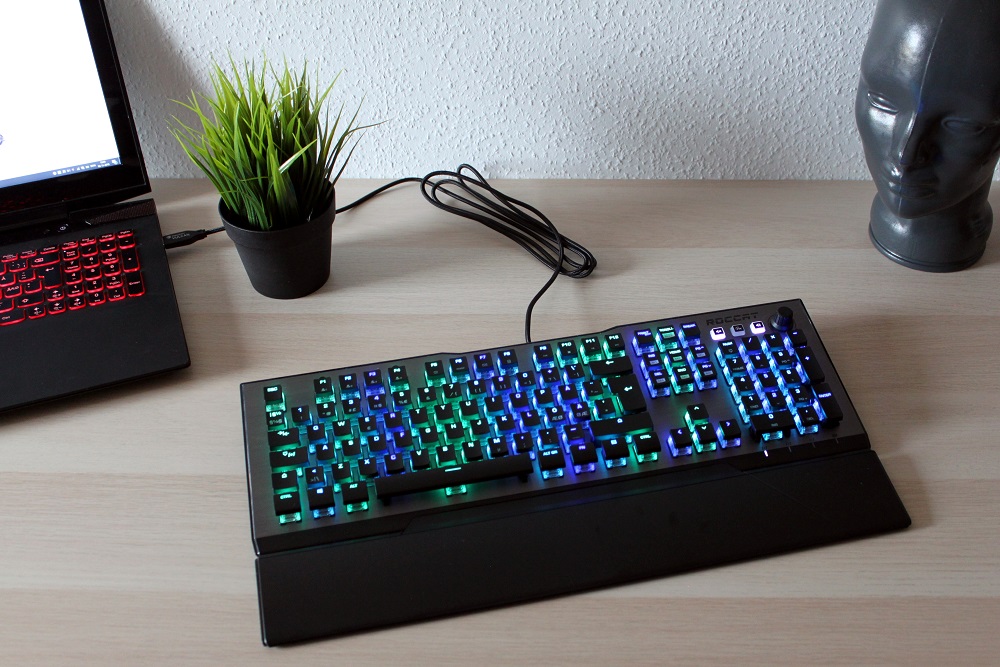
The last detail is the indicators. As you can see below, they are situated below the numpad. Not above, as we are all used to.
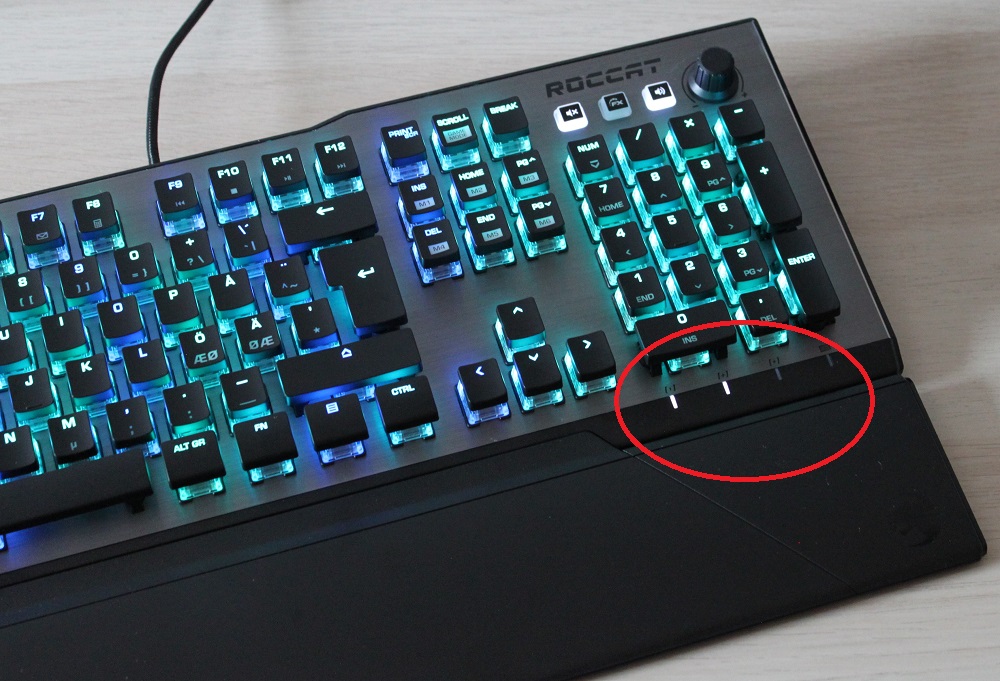
Pricing
Time to show the money. Vulcan 120 AIMO is priced at $159.99.
Even though this seems a little steep for a bunch of keys on a board, the price is modest compared to other high-end models. With Vulcan 120 AIMO you get a unique, ultra-thin design that is one-of-a-kind on the market. This, along with the loads of features and functions, makes the price more than fair.
If you want to know more about the Vulcan 120 AIMO jump over to the Roccat site here.
Conclusion
We haven’t said hello to a ROCCAT product for a while, which is a shame. With their new Vulcan series, they have proven that they should be recognized as a significant keyboard player.
Vulcan 120 AIMO has been my first experience with a low-profile mechanical keyboard. I must confess that it swayed me in several ways.
First and foremost, the slim design makes the keyboard extremely comfortable to use. This is further enhanced by the magnetic palm rest.
The unique Titan switches, coupled with the ultra-slim keys, give the keyboard the speed of a cheetah. This defies logic, as the specifications imply that it should be slower than my normal SoundBlasterX Vanguard K08. But it’s the other way around. Vulcan 120 AIMO makes the dust fly, and then makes my Vanguard bite it.
The knob in the upper right corner, controlling the volume and a custom function, is a nice feature, even though a traditional wheel might have been better. I understand that this might not have been possible, given the slimness of the keyboard, and a knob is better than nothing at all.
Whether you’re a fan of RGB or not, the lighting on Vulcan is dazzling. The brushed aluminum surface augments this by reflecting the light like in a Blade Runner movie, and you can gaze in awe at the rainbow, or even the single-colored themes.
The negatives are negligible, but there are two.
First, I’m not fond of the sharp edges of the keys. They are a tad uncomfortable when you miss a clean hit on a key, for example. This is a small detail, but worth a mention.
The software, ROCCAT Swarm, could also use some spring cleaning. I experienced on more than one occasion that the software crashed without saving any changes, forcing me to start over. I cannot say who’s the culprit, the software or my PC.
Nonetheless, we land on a 9/10 and a Great Product award. ROCCAT Vulcan 120 AIMO is a sublime product all the way through. Its features, design, and layout all leave the competition green with envy. Job well done!
Good:
- One of the first low-profile mechanical keyboards!
- Slick and slim design
- Lots of shortcuts with the FN-key
- RGB lighting with plenty of pretty colors and options
- Dedicated volume/function knob
- Magnetic palm rest included
- Impressive comfort!
- The low-profile keys are great…
Not so good:
- … but the edges are a little sharp
- The software could have been more stable

Latest keyboard
-
27 Febkeyboard
-
18 Febkeyboard
Logitech Pro X TKL Rapid
-
02 Deckeyboard
Glorious GMMK 3 Pro HE
-
12 Novkeyboard
Glorious GMMK 3 HE
-
05 Novkeyboard
Logitech POP Icon Combo
-
01 Novkeyboard
Corsair introduces the K70 PRO TKL
-
24 Octkeyboard
Logitech G915 X Lightspeed TKL
-
21 Octkeyboard
ASUS ROG Falchion Ace HFX
Most read keyboard
Latest keyboard
-
27 Febkeyboard
Corsair K70 Pro TKL
-
18 Febkeyboard
Logitech Pro X TKL Rapid
-
02 Deckeyboard
Glorious GMMK 3 Pro HE
-
12 Novkeyboard
Glorious GMMK 3 HE
-
05 Novkeyboard
Logitech POP Icon Combo
-
01 Novkeyboard
Corsair introduces the K70 PRO TKL
-
24 Octkeyboard
Logitech G915 X Lightspeed TKL
-
21 Octkeyboard
ASUS ROG Falchion Ace HFX






